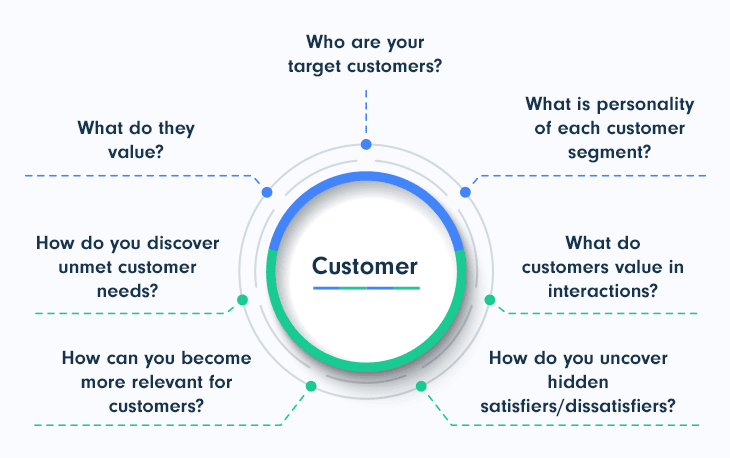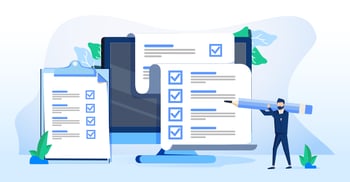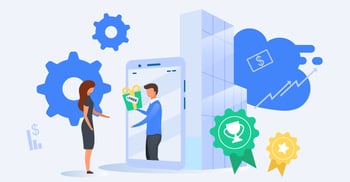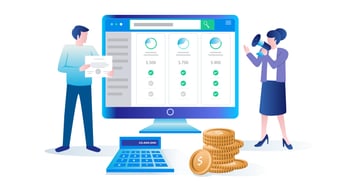The SaaS Pricing Guide You Need To Achieve Maximum Revenue
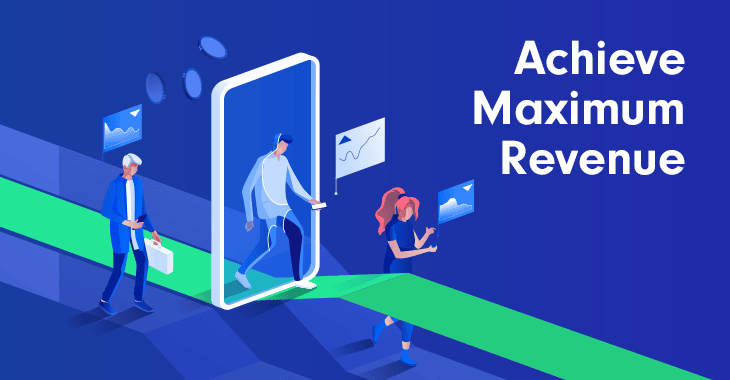
Here is a scary thought. SaaS companies spend only 6 hours to create and polish their pricing strategy. In total, that is, not on a monthly basis. That’s less than one working day.
What other process can you complete in that time frame?
With the SaaS developers being so keen on data, how come pricing is a gut decision?
It’s hard to wrap your head around it because a solid SaaS pricing strategy can skyrocket your business growth and considerably boost your revenue.
But before it can blow your mind with what it can do for your SaaS business, you need to understand how pricing works and how you can make the most of it.
Think of SaaS pricing strategies as jet cars. They’re fast and exhilarating but also easy to crash.
To help you find the right pricing for your SaaS pricing, we’ll be looking at:
What is SaaS Pricing?
4 Pricing Models For SaaS Businesses
SaaS Pricing Strategies To Hit Your Growth Goals
10 Essential Pricing Metrics To Track
What is SaaS Pricing?
SaaS pricing is how companies part of this industry choose to charge their customers.
In subscription-based business models, users make regular payments over an established period of time, making pricing a critical piece in the growth of a business.
Setting the right subscription price point is considerably more complex than monetizing traditional products.
SaaS businesses need to put more effort into developing the pricing options, as their decision could ultimately impact customer acquisition, retention, and revenue.
What’s To Gain For Smart SaaS Pricing?
The best piece of advice anyone could give you is to treat SaaS pricing as an experiment. What does this mean?
Test different strategies and techniques, provide customers different plans, monitor the results, and optimize your pricing page.
Seems like a lot to do, but considering what you can gain from developing and maintaining a flexible monetization strategy, it’s definitely worth it.
Gain the Upper hand
Penetration pricing, flat-rate pricing, usage-based pricing, per-user pricing, tiered pricing, the goal is to set a pricing model that fits the needs of the customer and generates sustainable revenue growth for the company.
It is essential that SaaS companies always be prepared to tweak their pricing strategy in response to changes in the market or shifts in customer demand.
Remaining flexible is necessary to stay competitive in a fast-evolving business landscape.
Offer a Sense of Value
Customers will continue buying products they feel good about, products they can justify.
Setting prices based on the value your users receive instead of those your competitors choose or business costs is the key to SaaS retention.
Through value based SaaS pricing, you are leveraging the power of user perception, boosting sales, customer loyalty, and brand reputation.
Explore a New Growth Avenue
In the subscription industry, the key to sustainable growth isn’t an increased acquisition rate. Absolutely, welcoming new customers is always good for business, but unless you can convince them to continue paying you over a prolonged period, it’s not enough.
The right answer to how can a SaaS business achieve long-term growth is correct monetization. Keep in mind that 11% of the profit growth is generated through a 1% price increase.
Know Your Market: 2 Major Technics
Understand Your Clients and Their Needs
Developing a reasonable pricing plan depends on your target audience. Creating thorough and correctly identified buyer profiles can aid you in better understanding their needs, wants, and motivations, which can help you make more informed pricing selections.
34% of SaaS businesses offer three tiers proving that creating targeted price points for your customer segments can also be a successful marketing tactic.
By doing so, you can raise the perceived value of your product and more effectively gauge each consumer segment's readiness to pay.
Also, as your client segments' needs may change over time, you should plan to review and assess them constantly. When appropriate, modifying your pricing plan to maintain its efficacy and competitiveness is an excellent move.
Identify Current Pricing Trends
Keeping your eye on pricing trends in the SaaS sector can help you maintain competitiveness and adapt to changing market conditions.
You might want to consider ML pricing tactics, which employ data analysis and algorithms to optimize pricing and sales.
Also, adapting pricing and product offerings to particular geographic locations and consumer segments, known as hyper localization, is worth considering.
And let’s not forget about usage-based pricing, one of the most popular SaaS pricing models out there, yielding excellent results for SaaS businesses.
Although these trends might be popular, it doesn’t mean that every company or product will benefit from them. The optimal pricing approach for your SaaS product must take into account your niche market and client needs.
The 5 Main Questions You Need to Answer to Price Your SaaS
Here are five questions to keep in mind when developing a pricing plan for a SaaS product:
Who is your target market, and how much are they willing to spend? Are you aiming your marketing towards small or large companies? Your pricing approach is likely influenced by your target market's needs.
What benefits do clients receive from your SaaS product, according to your value proposition? How does it alleviate their problems? This can assist in identifying the pricing tiers and levels that will appeal to your target market.
What pricing structures are your rivals using? Your own price strategy could be influenced by investigating pricing models and their rates of success.
What are your financial objectives? These objectives can help you identify pricing tiers and business models that will be most useful in accomplishing them.
How adaptable is your pricing strategy? It is advisable to make changes to your pricing strategy every six months, but it’s just as important to make sure your SaaS can quickly adapt to changes.
Knowing your business and its value proposition, comprehending your target market and its demands, and remaining flexible and open to changing your price as necessary are the keys to understanding how to price your SaaS product correctly.
4 Pricing Strategies for SaaS
There are several types of SaaS pricing strategies available on the market, but only you can decide which is ideal for your company. So, let’s look at the pros and cons of the four most popular ones.
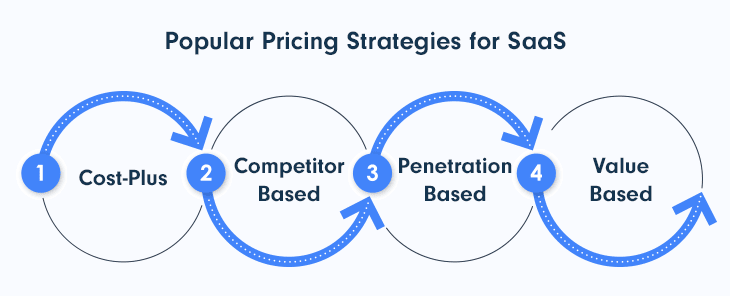
Cost-Plus Pricing
Cost-plus pricing is the conventional monetization method by means of which you are adding a profit margin to your production costs.
When calculating your production costs, you need to consider a wide range of expenses, including staff, research, and product development.
Advantages and Drawbacks
Cost-plus pricing is well-liked due to its simplicity. You'll always make some money, so it's a safe decision.
But cost-plus pricing won't always result in the highest possible revenue. You could be undervaluing your product if your operating expenses are low. Also, if unanticipated expenses arise that weren't factored into your initial estimates, you’ll wind up losing money.
Competitor-Based Pricing
The competitor-based pricing method determines rates based on what customers pay for competitor products. If you're just starting out and need clarification about where to target your pricing, this can be an excellent method.
Advantages and Drawbacks
While competitive pricing allows you to avoid price wars and position your product similarly to your competition, it might not necessarily highlight its actual value.
It’s important to consider competitor pricing, no doubt, but you need to do your homework before coming up with a price for your product and business strategy.
Penetration Pricing Strategy
Used intensively by startups and not enterprise companies, the penetration SaaS pricing strategy refers to purposely pricing your SaaS product lower than your competition to boost demand and gain market share.
Typically, you are sacrificing short-term profits, planning to recover the profits through customer upselling and cross-selling.
Advantages and Disadvantages
Even though this strategy produces fast outcomes due to the product’s low price, it cannot be regarded as a long-term approach. Penetration SaaS pricing strategy be utilized as a first step toward a more permanent and long-term pricing strategy because it is also not financially sustainable.
Value-Based Pricing
Value-based pricing looks at the customers using the product. Through this monetization tactic, you price your product based on your user’s willingness to pay in exchange for the value offered.
Advantages and Drawbacks
Because you can typically stay in touch with your clients and make adjustments as necessary when you see fit, this is a strategy that requires having a good relationship in place.
The drawback is that it takes time. Value-based pricing means a lot of early work to generate the required data.
Also, consumer tiers could value your products differently, making it difficult to set a fixed price. This is a somewhat intricate tactic that needs careful consideration and ongoing structure-focused thought in order to be successful.
7 Best Pricing Models for SaaS
A pricing model is how you package the monetization of your product or service. Even though there are multiple types of SaaS pricing models, the majority of SaaS businesses gravitate around seven of them. So, let’s discover them!
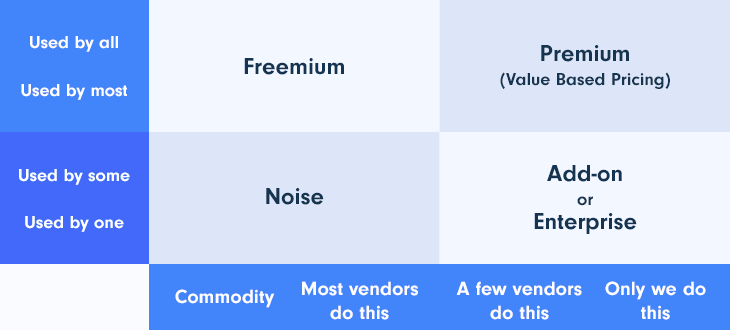
Freemium Pricing
Different from the free trial, in the freemium pricing model, you offer a basic free-to-use product, with paid packages available in order to access more features.
This is part of a tiered strategy. The idea is to draw more customers in with a free version, which generally has limited capabilities. Later, your sales and marketing team members follow up and encourage users to upgrade to acquire more functionality.
Freemium Pricing: Pros and Cons
Freemium has a quick initial adoption and low customer-acquisition costs (CAC), making it very interesting for many SaaS companies.
Plus, it’s simple to monetize. You can use ads in the free version and push reminders to upgrade as customers come up against the limits of the basic functionality being offered.
The free version makes for a great place to test new features without affecting the area of your business generating revenue.
On the downside, however, free users don’t generate revenue for the company, so you’re carrying the costs of acquiring both free and paid customers. Typically, only a small percentage will convert to paying customers.
Also, churn is high with free customers, as they are less likely to value something for which they aren’t paying and then decide to no longer use it. And if your product offers real value to users when it’s free, they may not be willing to pay for it later.
Freemium should be seen as a first step to driving leads and should only be attempted by businesses who know how to convert these leads to paying customers.
Freemium Pricing Examples:
Evernote: This SaaS app offers three tiers, a free one equipped with basic features, followed by a personal package and a team version. As the price increases, so do the features offered.
Canva: Users may choose the right plan for their needs, considering either a free plan with limited functionality or paid tiers. If customers want a more complex version of the online design app, they can choose the Pro or Team tier.
User-Based Pricing
User-based pricing model means SaaS companies are charging per the number of customers they have, so obviously, more customers mean more revenue.
It’s a simple system that makes it easy to forecast revenue, so it has become a popular model. Usage-based pricing is highly appreciated by cloud-based collaboration apps like Slack or Asana.
User-Based Pricing: Pros and Cons
The most significant benefit here is simplicity. Customers can calculate their monthly costs and efficiently work out their revenue as the business scales.
On the other hand, the user-based pricing model can put your revenue at risk of being compromised with login abuse, where multiple people use a single login to avoid paying more.
Also, if financial situations change for the worse with your customers, their organization may limit the number of customers using your product to save money without considering the value of your product.
Stop guessing the right price for your product. Trust PayPro Global to help you with your SaaS pricing strategies and start growing your business with our complete payments solution. Driving revenue has never been simpler.
User-Based Pricing Examples
Asana: This collaboration tool does a great job at combining the freemium pricing model with the user-based technique by offering multiple packages in terms of features and number of users.
Hubspot: The well-known marketing automation tool does a great job at provisioning potential customers with a wide range of plans, perfectly responding to their usage (number of users) and system capability needs.
Flat-Rate Pricing
Flat-rate pricing keeps it simple ‒ a single product, one set of features, and one price. A one-size-fits-all strategy, where customers are charged one rate no matter how many users there are or what amount their usage is.
Flat-Rate Pricing: Pros and Cons
Flat rate pricing is easy to sell and communicate to customers. They can sign up effortlessly, as the decision-making process is very straightforward.
However, it does leave you with just one opportunity to get potential customers on board. There’s no personalization, flexibility, or customization in the flat rate pricing model. If they aren’t happy with your offering, you’ll lose them.
Also, you can’t upsell to them, which is one of the reasons why many SaaS companies avoid using flat rate pricing.
Generally speaking, your pricing is aimed at a specific market, so breaking into new markets can be challenging, to say the least.
Flat-Rate Pricing Examples:
The New York Times: To subscribe to the digital version of the very famous magazine, readers need to make a weekly payment of €0.50/week or €20/year.
Disney Plus: This streaming service has a fixed per month fee users need to pay in order to gain access to the content available.
Basecamp: When visiting their pricing page, you will notice two main packages, a free option and a paid one. This is a clear example of a solid combination of two main SaaS pricing models, freemium and flat-rate.
Usage-Based Pricing
One of the most popular SaaS pricing models, usage-based pricing isThis model is also known as “pay-as-you-go”.
In this model, SaaS customers charge their customers based on the number of API requests, payments processed, or gigabytes of data used.
Usage-Based Pricing: Pros and Cons
For customers, the benefit is that the price only scales with usage. This is attractive to low-usage customers since they know they can start small and increase costs over time.
It’s a fair system that is adaptable, and it can and does attract a broad audience.
The downside is that this model disconnects your product from its value. You could lose out on per-user revenue since you would not be charging e based on the size of an organization.
It’s also tough to predict revenue as your customers’ usage may vary significantly from month to month.
This also means it’s difficult for potential customers to predict and monitor costs. Some customers may churn because their expenses get too high, and, in their minds, usage doesn’t equate with value.
Usage-Based Pricing Examples
SendGrid: This communication platform combines different SaaS pricing models to offer customers using the product different packages to choose from.
Mailchimp: The popular automation tool provides several plans having distinct features so users can determine the right pricing for their needs.
Tiered Pricing
Tiered pricing models are some of the most popular among SaaS business owners.
A tiered pricing strategy offers a number of different packages to customers, providing access to various product features or number of seats and usage, each priced differently.
Tiered Pricing: Pros and Cons
Here you can cater to multiple buyer personas, from low users to heavier ones. The customer chooses what suits them best.
You don’t undercharge customers or raise prices based on what they are willing to pay, and it’s easy to upsell for increased MRR (Monthly Recurring Revenue). When customers reach the limits of their monthly fee plan, they can then upgrade.
However, too many pricing tier choices can become confusing and difficult for a customer.
From the business side, offering too many options can make pricing overly complicated.
It’s worth noting that if you have any heavy users, you can’t collect any extra revenue from them past a certain point.
Tiered Pricing Examples:
Honeybook: This is a client management tool that provides users with different price points, allowing them to choose the best pricing for their budget, business, and usage needs.
Snowflake: The data analytics platform helps customers choose the right package for their needs by providing them with four main tiers and two on-demand options for customers using the product extensively.
Zoho CRM: Providing users with four different tiers based on the number of features available that can be billed either per month or annually, Zoho makes it easy for customers to choose the right option for them.
Feature-Based Pricing
The feature pricing model is similar to tiered pricing, but the tiers are based on features as the valued metric.
More features and functionality equal a higher price. The customers, therefore, scale along with the product as they grow.
Feature-Based Pricing: Pros and Cons
This feature pricing model allows customers to only pay for what they need, saving them valuable dollars and making this an attractive option.
And they can always upgrade when they need more functionality making it affordable for businesses. You can put your most costly features at the highest tier, managing your margin effectively.
The tricky element of per-feature pricing is knowing what features customers will want and need. Sometimes they don’t even know this themselves, and you’ll have to tell them. They need to be able to access enough features not to feel resentful of what is locked in the higher tiers.
At the same time, you ensure that the functionality, and therefore your profit, is not concentrated in the lower, cheaper tiers.
Feature-Based Pricing Examples:
Zoom: This video conferencing platform offers several plans, packed with a different set of features. For example, the basic plan has only six features included, whereas the enterprise package has increased functionality designed to sustain the needs of large SaaS companies.
Shopify: Enjoying immense popularity, Shopify offers three different packages, starting with basic options with reduced features and going up to the advanced version that includes custom reporting and access to 1,000 inventory locations.
Per Active User Pricing
The per-user pricing model is a variation of the user-based model. Businesses choosing the per user pricing model only bill customers who are actually using the software. Hence, the per active user mention.
Per Active User Pricing: Pros and Cons
The per user pricing system is beneficial for customers since, at an enterprise level, they don’t take as much risk when trying a new product.
But it doesn’t work as well for Small and Medium-Sized Businesses (SMBs). You may also come up against the problem of multiple logins as companies try to cut corners.
That is why it’s preferable to use the per user approach combined with tiered pricing to ensure that you can effectively service small and large companies.
Stop guessing the right price for your product. Trust PayPro Global to help you with your SaaS pricing strategies and start growing your business with our complete payments solution. Driving revenue has never been simpler.
Per Active User Pricing Examples
Jira Allign: This agile planning solution practices a different approach but very close to the actual meaning of the per-user pricing model, offering an estimated cost for different usage tiers.
Buffer: Because this is a social media marketing tool, the usage version takes the form of channels. The tiers provided differ when it comes to the access granted to social media channels and not to the number of users welcomed in the app.
4 Psychological Pricing Tactics
Whether you choose penetration pricing coupled with the free trial and choose to combine it with the per active user models, your work is never actually done. SaaS companies need to constantly monitor and further customize their pricing to ensure they capture as many users are possible.
Even though it is still stigmatized, the truth is that psychology comes in handy in this department. So, here are a few tactics to continue improving your SaaS pricing scheme.
Charm Pricing
Charm pricing is the use of prices ending in the digit nine, usually in the tiered pricing model. Not only SaaS companies use this tactic, but the majority of businesses, regardless of industry. And there is a scientific explanation, called the Left Digit Effect, behind its success.
As it turns out, our brains quickly process numbers and unconsciously make comparisons. Our memory, however, holds on to the first number.
So, let’s say we see a price tag of $40 and then another one of $39. Our brain will consider the second one a better offer simply because it associates the $39 product closer to the $30 price point.
Of course, a customer’s price analysis will go beyond this unconscious first impression, it has been demonstrated that charm pricing can increase sales and the conversion rate.
Dropbox, Shopify, and Canva include this tactic in their pricing strategy.
Scarcity Pricing
Scarcity is the practice of making potential customers that a product is available in a minted supply.
It’s true that this tactic holds more popularity when selling physical products because of the idea of stock, but it has been successfully adapted to the realm of SaaS and software products.
For example, when launching a new product or a new feature, SaaS companies reward eager customers with a promotional price point over a limited timeframe.
Studies have shown that this practice appeals to customers because it creates a sense of urgency, and they feel more compelled to act fast.
Odd Even Pricing
Odd-even pricing is the next level in charm pricing. Used in highly competitive markets, SaaS companies looking to reach customers choose to have price points ending in odd digits, like $47 or $367.
This method is not about practicing a lower price than the competition, like the penetration pricing strategy. It’s more about capturing the attention of customers who have gone blind to charm pricing principles.
Going deeper in the price analysis, customers will correctly associate a $29 product with a $30 one. But they might not reach the same conclusion when comparing a $347 one with a $400 price tag.
And it might just be enough to increase your conversion rates.
Product Bundling
Product bundling is the practice of providing several products for the price of one. To encourage the sale of the bundle, SaaS companies should offer each product for a low price, lower than it could be purchased individually.
Through the method, you are steering attention from one-product price points and encouraging a more outcome-oriented perspective. This can ultimately lead to the adoption of the value based pricing tactic, which can yield great results.
Additionally, it’s worth noting that product bundling can be regarded as a highly effective way to gain additional revenue when used as cross-selling.
9 Steps to Choosing the Right SaaS Pricing Model
Selecting a pricing model is an ongoing process that needs to be not only customer-focused but regularly revisited. You’ll need to gather data and consult various sources. Only then can you put the pieces together to finalize your pricing. We suggest these tips for getting started:
1. Check your finances against projected revenue.
This will help you evaluate where you are financially and where you’d like to be in the future.
2. Conduct research on what your competitors have to offer.
This can be done through a competitive analysis focusing on their strengths and weaknesses. Then, you can either decide to beat their price or their value.
3. Analyze and optimize the relevant metrics.
Know your LTV/CAC value, as this can help you determine whether a pricing model will be good for the general health of your business. When the customer acquisition cost is high, you need a pricing model that increases the user lifetime value to balance things.
4. Pull other teams into the pricing conversation.
Marketing, Product, Sales, and Management teams can all offer valuable insights.
5. Utilize your buyer personas.
Using the information you have previously gathered, create buyer personas to effectively position your product in the market and reach the correct audience.
6. Develop pricing tiers.
Create different pricing structures that fit all your buyer categories, from startups to enterprise-level customers to package and sell your product effectively.
7. Consult your current and prospective customers
Always ask for feedback. It is very important to stay in close contact with your audience and to seek out customer opinions because frankly, they know best.
8. Make sure you don’t undercharge or overcharge your client.
If you undercharge, they’ll most likely undervalue your product. However, if you overcharge, you could send potential customers to your competitors.
9. Choose a strategy and plan
Always take the time to develop an operating method that best suits your business model while continuing to make small changes to your pricing plans until you reach the best solution.
10 Metrics For Tracking SaaS Pricing Effectiveness
Metrics are essential for SaaS companies' ability to monitor the success of their pricing plans. A SaaS company should make data-driven decisions and optimize pricing for increased profitability by keeping an eye on a few key metrics to learn more about how their pricing models are doing.
Among the crucial metrics that SaaS providers monitor to assess their pricing strategies are:
CAC
Customer Acquisition Cost (CAC) is the term used to describe the expense a business incurs while acquiring a new customer. A lower CAC suggests effective pricing since the business is adding customers at a cost that is reasonable.
CLTV
Customer Lifetime Value (CLTV), calculates the overall revenue a client contributes to the business over the course of their relationship. A greater CLTV indicates successful pricing because the business is getting more money from its clients.
Churn Rate
The churn rate is the frequency with which consumers discontinue their subscriptions. Low customer turnover suggests efficient pricing because it implies that users are happy with the service and perceive value in sticking with it.
MRR
The term "monthly recurring revenue" (MRR) refers to the sum of all monthly revenues produced by all clients. Greater MRR conveys efficient pricing because it shows that the business is getting more money from its clients.
ARPU
Average Revenue per User (ARPU), is a metric that assesses the typical revenue produced by each client. A higher ARPU shows effective pricing because the business is making more money from each client.
Gross Margin
The distinction between revenue and cost of products sold is known as gross margin. A larger gross margin suggests effective pricing because the business is making more money off of its sales.
Conversion Rate
This metric calculates the proportion of website visitors who eventually make purchases. A greater conversion rate suggests successful pricing because the business is drawing in more clients who are willing to pay.
Price Sensitivity
It measures how sensitive consumers are to price fluctuations. Because clients are willing to pay for the service even if the price changes, lower price sensitivity shows successful pricing.
Competitive Positioning
This metric displays where a business stands in relation to its rivals. Effective pricing is indicated by a company's strong competitive positioning since it is providing a compelling value proposition.
Customer Satisfaction
This metric is a measure of how satisfied and devoted customers are. Greater customer satisfaction suggests efficient pricing since users value it and are likely to stick with it.
Overall, your decision making processes need to be triggered by essential SaaS metrics. After all, these allow developers to track the success of their pricing strategies, pinpoint areas for development like customer service or onboarding operations, and make data-driven decisions that will optimize pricing and promote growth.
When Should You Change Your SaaS Pricing Model?
SaaS pricing is a work in progress. Gathering as much knowledge on what effecting pricing looks like, as well as quickly recognizing the moments in which you should start altering their pricing structure, are key ingredients in improving your conversion rates.
And speaking of changes, when should you start working on your pricing?
Consumer feedback: If customers are frequently complaining that the pricing plan is complicated or expensive, it might be time to think about changing it.
Market circumstances: The market is subject to quick change, and rival companies can have a more enticing pricing structure. To remain competitive, SaaS providers must keep track of market shifts and modify their pricing strategies accordingly.
Product or service changes: It could be necessary to update the pricing model when a new product or service is developed or when new features are added.
Price tests: A SaaS company may conduct pricing tests to identify the most effective pricing plan. These experiments can indicate that a change is required.
Client acquisition and retention: A SaaS business may need to alter its pricing strategy in order to draw in new clients or keep hold of current ones. For instance, a business can think about using a freemium pricing structure to draw in new customers.
Scalability: When a SaaS business expands, it may be necessary to modify its pricing strategy to account for rising demand and consumption.
In conclusion, a range of considerations, including customer feedback, market conditions, modifications to the product or service, price experiments, customer acquisition and retention, and scalability, should be taken into consideration when adjusting a SaaS pricing model. The secret is to continuously track metrics and maintain flexibility to quickly make necessary adjustments.
Using SaaS Pricing Models to Boost Your Revenue
By choosing an optimal pricing model, you’ll be able to gain an advantage over your competitors. A Price Intelligently study found that pricing is four times more effective than the acquisition of customers in terms of improving growth. FOUR TIMES!
In SaaS, success means your LTV must be much higher than your CAC. By pricing effectively, you’ll be lowering your CAC by targeting ideal customers and increasing your LTV through higher prices and better retention of customers.
Optimizing pricing is vital for better growth, a more resilient business, and higher revenues.
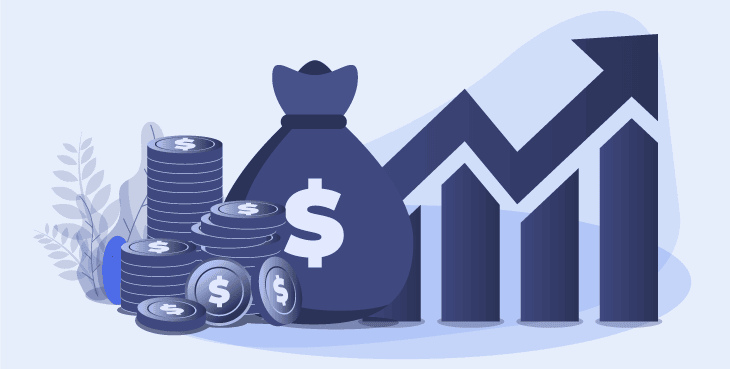
How can PayPro Global Help?
Our complete, all-in-one eCommerce solution gives you the tools you need to test various SaaS pricing strategies or models, anything from per user pricing to feature pricing or flat rate.
Moreover, through free trials and demos, PayPro Global helps your SaaS business identify the right way to engage different customer profiles and, ultimately, validate the best-performing model for your needs.
Additionally, thanks to our AI-power SaaS metric and BI tools, you can back all your business decisions with real-time data.
You can easily monitor the entire SaaS pricing strategy or sales processes, use the over 70 reports we offer, and decide on the correct pricing strategy capable of significantly boosting your revenue.
Visit PayPro Global or reach out to find out how we can help you stay on top of your SaaS pricing strategy.
The Right Guidance To Help You Grow
Effective pricing is a key element in the success of any SaaS business. Still, finding the optimal strategy can be tricky - it's essential to have an expert on your side! Dive deep into this important topic with PayPro Global Founder & CEO Meir Amzallag and unlock unlimited opportunities for growth through smart pricing decisions.
Concluding Thoughts On How To Price Your SaaS For Maximum Revenue
Developing an effective SaaS pricing strategy can be confusing and overwhelming, but it isn’t impossible.
Do the research, keep your customers top of mind, and try strategies and different pricing models until you find the one that suits your business and will generate the maximum revenue.
At PayPro Global, we’ve been in the business of helping companies that sell video games online, software, SaaS, and other digital goods grow their business globally through localization strategies.
Our platform is robust, offering you the marketing and sales tools you need to scale, and our team is experienced in payment solutions and able to get you up and selling immediately. We can help you strategize not only your pricing but work with you as your trusted partner in all things eCommerce.
FAQ
What is SaaS pricing?
SaaS pricing is a business model where you charge customers a recurring subscription fee for access to your software. This can be done on a monthly or annual basis, and usually allows customers to cancel their subscription at any time.
How is SaaS pricing done?
SaaS pricing is generally done in two ways: subscription-based or usage-based.
1) Subscription-Based sass Pricing
With subscription-based pricing, customers pay a recurring fee, typically monthly or annually, to access and use the software. The amount they pay is generally based on the features and functionality they need, as well as how many users will be using the software.
2) Usage-Based SaaS Pricing
With usage-based pricing, customers are charged based on how much they actually use the software. This could be measured in terms of data storage, number of transactions, number of users, etc.
How is SaaS price tested?
SaaS pricing is tested in a number of ways, but the most common way is using something called a price elasticity test. This simply means testing how sensitive users are to price changes. For example, you might release two versions of your software, one at $10/month and one at $20/month, and see which one generates more revenue.
Ioana Grigorescu
Ioana Grigorescu is PayPro Global's Content Manager, focused on creating strategic writing pieces for SaaS, B2B, and technology companies. With a background that combines Languages and Translation Studies with Political Sciences, she's skilled in analyzing, creating, and communicating impactful content. She excels at developing content strategies, producing diverse marketing materials, and ensuring content effectiveness. Beyond her work, she enjoys exploring design with Figma.
-
1.Explore PayPro Global's Solutions: See how our platform can help you streamline your payment processing and boost revenue.
-
2.Get a Free Consultation: Discuss your specific needs with our experts and discover how we can tailor a solution for you.
-
3.Download our Free Resources: Access valuable guides, checklists, and templates to optimize your online sales.
-
4.Become a Partner: Expand your business by offering PayPro Global's solutions to your clients.
Get the latest news
